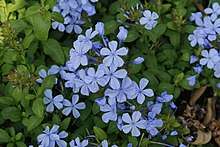Plumbago auriculata
| Plumbago auriculata | |
|---|---|
 | |
| Plumbago auriculata | |
| Scientific classification | |
| Kingdom: | Plantae |
| Clade: | Angiosperms |
| Clade: | Eudicots |
| Order: | Caryophyllales |
| Family: | Plumbaginaceae |
| Genus: | Plumbago |
| Species: | P. auriculata |
| Binomial name | |
| Plumbago auriculata | |
| Synonyms[1] | |
| |

Plumbago auriculata (common names blue plumbago, Cape plumbago or Cape leadwort), syn. P. capensis, is a species of flowering plant in the family Plumbaginaceae, native to South Africa.[2][3]
It is an evergreen shrub, often grown as a climber, ascending rapidly to 6 m (20 ft) tall by 3 m (10 ft) wide in nature, though much smaller when cultivated as a houseplant.[4] It has light blue to blue flowers and also variations with white (P. auriculata var. alba) or deep blue (P. auriculata 'Royal cape') flowers. The leaves are a glossy green and grow to 5 cm (2 in) long.[2][3] Plumbago grow best in full sun to part shade.
The specific epithet auriculata means "with ears", referring to the shape of the leaves.[5]
Medicinal uses and phytochemistry
Plumbago auriculata is a medicinal herb plant. The name has a root from the Latin word plumbum, meaning lead, because it has some pharmaceutical effects for lead poisoning (Asha Saji, V. T. Antony,2015) . Also it is used as a phytoremediator for lead and cadmium.
Many secondary metabolites have been discovered and isolated from Plumbago auriculata such as Plumbagin, palmitic acids.[6]
Cultivation
In temperate regions it may be grown outside in frost free areas, otherwise under glass. The species[7] and the white-flowered form P. auriculata f. alba[8] have both gained the Royal Horticultural Society's Award of Garden Merit.[9]
Plumbago auriculata can be propagated sexually by seeds and asexually by cutting in summer. It needs well-aerated soil and light and prefers acidic soil.
References
- ↑ "Plumbago auriculata". The Plant List. Retrieved 2018-01-27.
- 1 2 "Botanica. The Illustrated AZ of over 10000 garden plants and how to cultivate them", p 691. Könemann, 2004. ISBN 3-8331-1253-0
- 1 2 Nico Vermeulen:"The Complete Encyclopedia of Container Plants", p. 216. Rebo International, Netherlands, 1998. ISBN 90-366-1584-4
- ↑ RHS A-Z encyclopedia of garden plants. United Kingdom: Dorling Kindersley. 2008. p. 1136. ISBN 1405332964.
- ↑ Harrison, Lorraine (2012). RHS Latin for gardeners. United Kingdom: Mitchell Beazley. p. 224. ISBN 9781845337315.
- ↑ de Paiva, Selma Ribeiro; Figueiredo, Maria Raquel; Kaplan, Maria Auxiliadora Coelho (2005-07-01). "Isolation of secondary metabolites from roots of Plumbago auriculata Lam. by countercurrent chromatography". Phytochemical Analysis. 16 (4): 278–281. doi:10.1002/pca.841. ISSN 1099-1565.
- ↑ "RHS Plant Selector - Plumbago auriculata". Retrieved 28 May 2013.
- ↑ "RHS Plant Selector - Plumbago auriculata f. alba". Retrieved 28 May 2013.
- ↑ "AGM Plants - Ornamental" (PDF). Royal Horticultural Society. July 2017. p. 80. Retrieved 7 May 2018.
| Wikimedia Commons has media related to Plumbago auriculata. |